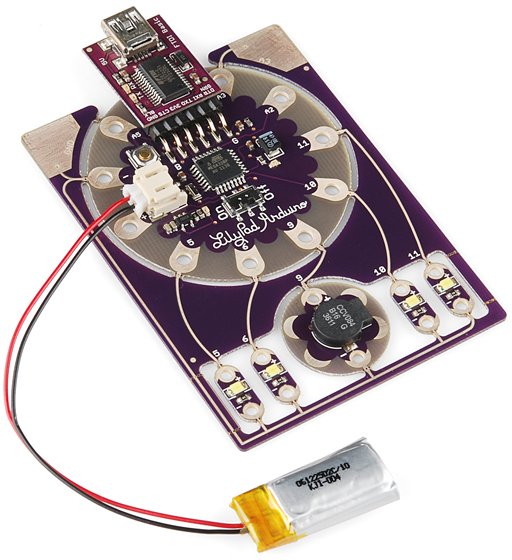ProtoSnap LilyPad Development Simple Hookup Guide
Introduction
Interested in getting into LilyPad? Or maybe it's Arduino that tickles your fancy? Just want to add a little white-blinky-LED zest to your vest? All of the above? The ProtoSnap LilyPad Simple is a great tool to explore any of these subjects.
This tutorial is aimed at getting the reader familiar with a variety of topics including: LEDs, LilyPad, Arduino, buzzers, and just circuits in general. I'll cover the basics, like what's going on with all those copper traces all over the ProtoSnap, and what an LED does. We'll also discuss the steps required to load your first Arduino sketch onto the ProtoSnap.
Following that, we'll actually demo how you can make something with the ProtoSnap. We'll be breaking the pieces apart to build a high-tech fabric raygun!
Before we begin though, I'd just like to say one thing. You've probably seen this warning a few times, but just to reiterate:
Don't snap the ProtoSnap apart! Yet.
Continuing on then...
Before You Begin
This tutorial builds upon some concepts ranging from basic electronics to sewing. If you haven't already, it may help to review some of these tutorials:
- E-Textile Basics - Learn the basics of wearable electronics.
- Sewing with Conductive Thread - In the latter half of the tutorial, we'll be breaking apart the ProtoSnap and sewing it all back together. This tutorial explains the basics of working with conductive thread.
- Firefly Jar - This is one of the more basic e-textile circuits out there. You may want to try this one out before going all out with this example.
And there are a few general electronics concepts which might help to know a bit about:
- What is An Arduino? - The ProtoSnap LilyPad Development Simple board has an Arduino! Check out this tutorial if you're unfamiliar with what, exactly, this Arduino thing is.
- Voltage, Current, Resistance, and Ohm's Law - The fundamental rules governing all circuits, whether they're wearable or soldered.
- Series and Parallel Circuits - It helps to have a very basic understanding of series and parallel circuits

